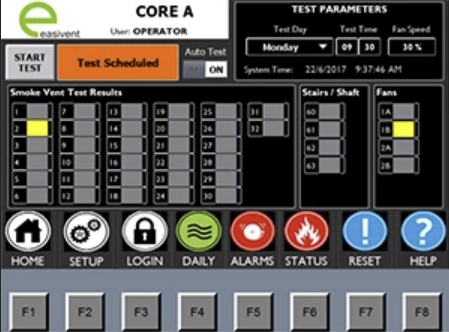New remote testing device ensures you don’t turn a blind eye to smoke control maintenance
New remote testing device ensures you don’t turn a blind eye to smoke control maintenance
Smoke control systems are an important fire safety measure for high-rise residential buildings. They are provided to keep escape routes clear of smoke to allow people to safely exit the building in an emergency and to allow firefighters clear access to fight the fire and carry out rescue operations.
As with all mechanical and electrical services within buildings, the system is only effective if it is adequately maintained and kept in good working order.
The Regulatory (Fire Safety) Reform Order (RRO) 2005 details the requirement for the maintenance of life-safety systems, but can often be overlooked or not fully understood.
The RRO (2005) stipulates that the responsible person must ensure that the premises, facilities, equipment and any devices for use by or for the protection of firefighters and relevant persons, are subject to a suitable system of maintenance and are maintained in an efficient state, in efficient working order and in good repair. The RRO (2005) states that it is an offence for any responsible person or any other person with control of a premises, to fail to comply, where that failure places one or more relevant persons at risk of death or serious injury in the case of fire.
Therefore, we understand from the RRO that life-safety systems must be maintained by law. Failure to do so could result in death or injury and prosecution for failing to comply.
BS EN 12101 and BS 9999 set out the frequency of tests and what should be checked.
Weekly tests of the system should be carried out to check the operation of the system. For mechanical systems, checks should be made to determine whether the fans are running satisfactorily and that the ventilation system has operated. Where there is a back-up generator in place, the fuel level should be checked and topped up as necessary.
Monthly tests should be carried out in addition to weekly tests. During the monthly test, the failure of the primary power supply should be simulated and a check made that the system has automatically switched over to the secondary power supply. Where the secondary supply is via a back-up generator or power cell (battery or UPS), the secondary supply must be able to energise the system for a minimum of three hours. A zero airflow condition should be simulated to check that the system switches automatically to the standby fan/s and that they are running satisfactorily.
The weekly and monthly checks will typically be carried out by general maintenance personnel for a building who have received basic hands-on training from the manufacturer/installer of the system.
If the systems are maintained by a competent organisation they will at best be tested at six-monthly intervals during service visits.
In reality the weekly and monthly tests are problematic, particularly for high-rise residential buildings where there is no on-site maintenance presence and as a result they are frequently overlooked.
This means that if a fault occurs during the period between visits it may go unnoticed and the system would remain inoperable until the next scheduled maintenance visit. Even when smoke control systems are equipped with visual and audible fault alarms, these are often ignored in residential buildings where there are no on-site security personnel, so under this regime there is a very real risk of a system failure in an emergency.
For high-rise residential developments, we would question whether it is realistic for system providers to specify weekly testing of smoke control systems that involve a lengthy process of checking every floor on multi-storey buildings when there are unlikely to be personnel available to carry out such tests. This could be seen as passing an unrealistic burden onto building owners and operators, when in reality the system provider should know from experience that this work is unlikely to be carried out.
Remote monitoring of fire alarm systems has been in common use for many years but has not commonly been available for smoke control systems until now.
SCS Group is making this available for the first time with the launch of the SCS Eyeball, which has been developed to give peace of mind for owners, operators and tenants of tower blocks.
The Eyeball is an intelligent device that connects to the smoke control data network and constantly monitors the system. In addition, Eyeball – which is a subscription service – can be programmed to schedule weekly tests of every component on the system and to issue a compliance report to the building operator or facilities manager to certify that the system is healthy. This can be by email or SMS. Any faults occurring are detected and a message is sent to the facilities manager and the smoke control maintenance specialist. Remote interrogation and testing can be carried out at any time via the internet.
This unique product reduces visits to site, ensures that system failures are detected and rectified promptly and is a cost effective way for building owners to fulfil their obligations under the Regulatory Reform Order.
For further information on the Eyeball device go to http://info.easivent.co.uk/eyeball-info
Published July 2017


